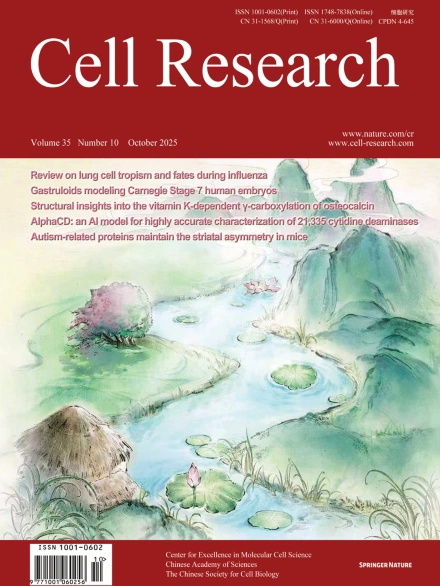
Advanced Search
Submit Manuscript
Advanced Search
Submit Manuscript
Volume 35, No 10, Oct 2025
ISSN: 1001-0602
EISSN: 1748-7838 2018
impact factor 17.848*
(Clarivate Analytics, 2019)
Volume 35 Issue 10, October 2025: 762-774 |
Autism-related proteins form a complex to maintain the striatal asymmetry in mice
Yisheng Jiang1,2,3,* , Feipeng Zhu2 , Jie Zhong2,3 , Xiaomei Sun2,3 , Yuting Yuan2,3 , Shuo Wang2,3 , Haiyang Chen2,3 , Zhiheng Xu1,2,3,*
1Second Affiliated Hospital, Zhejiang University School of Medicine, Hangzhou, Zhejiang, ChinaThe brain’s hemispheres exhibit profound lateralization, yet the underlying mechanisms remain elusive. Using proteomic and phosphoproteomic analyses of the bilateral striatum — a hub for important brain functions and a common node of autism pathophysiology — we identified significant phosphorylation asymmetries. Particularly, the phosphorylation processes in the left striatum appear more prone to disturbance. Notably, SH3RF2, whose single-copy knockout leads to autism spectrum disorder (ASD)-like behaviors in mice, is uniquely expressed in the striatum, forming a complex with CaMKII (an ASD-associated protein) and PPP1CC. Loss of SH3RF2 disturbs the CaMKII/PP1 “switch”, resulting in hyperactivity of CaMKII and increased phosphorylation of its substrate GluR1. In Sh3rf2-deficient mice, heightened GluR1-Ser831 phosphorylation and its aberrant postsynaptic membrane localization in the left striatum may impair the functional lateralization of striatal neurons and contribute to autism-like behaviors. This study unveils the first molecular mechanism governing brain lateralization in mammals, linking its impairment to autism development and treatment strategies.
https://doi.org/10.1038/s41422-025-01174-9